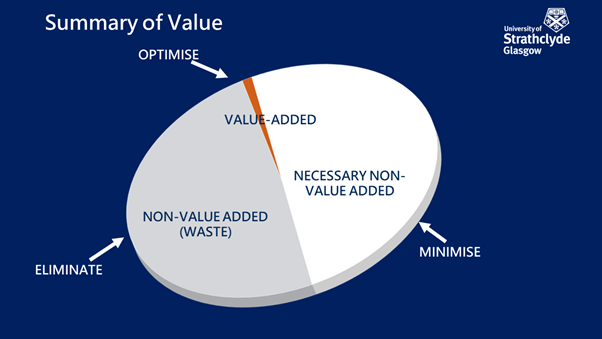“Lean thinking defines value as providing benefit to the customer; anything else is waste”. Eric Ries.
Value-added steps in a process are those in which you add something to a product or service for which the customer would be willing to pay.
As we work away in our day-to-day lives, one question I think we should regularly ask ourselves is, “Are we adding value?”
Defining 'value'
Value is the importance, worth, or usefulness of something often expressed in monetary terms.
“Value adding activities” are anything we do to transform materials or information into something that people we serve require. For instance, a baker may take the ingredients of flour, yeast, salt, and water and transform them into a delicious loaf of bread. Netflix curates several different types of films and makes them instantly accessible to us for a monthly fee.
The key point is that when we add value, we transform some key components into something that people are willing to pay for. It's generally agreed that there are only three types of activity that are happening in any process.
Value adding activities
These are activities, that add value, which we have just discussed. We like these. These are our friends.
So, what other types of activities are there? Two more types do exist but are not as helpful. These are: Necessary non-value-adding activities and non-value-adding activities or waste.
Hold onto your seats because this may get a bit scary.

When you review the time, it takes from someone requesting something, to its being delivered, I would like to humbly suggest that about 1% of the time is taken up with value-adding activities, 49% is necessary non-value-adding activities and 50% is waste or put another way something that you would not be willing to pay for. So, only a tiny percentage of our time adds any value. I told you it was scary.
Necessary non-value-adding activities
These can be defined as something that consumes resources, does not create any value for the customer, but is still currently necessary to supply the service. These activities can be quite difficult to eliminate in the short term and removing them can often lead to problems if a new solution is not properly tested before changes are made. For instance, switching over to e-mailing important documents to clients, rather than using snail mail, without checking that all clients can use the electronic facility.
Non-value-adding activities or waste
Waste can be defined as any activity that consumes resources but does not create any value for the customer. For instance, if a student must wait in a queue for 60 minutes to register at their new university does this add any value to their lives? I don’t think so. Taiichi Ohno, who was one of the pioneers of Lean thinking described Toyota's approach as follows:
“All we are doing is looking at the timeline, from the moment the customer gives us an order to the point that we collect the cash. And we are reducing the timeline by reducing the non-value-adding activities”
Let’s go for a trip
I’d like you to think for a moment about your experience of going to the airport to catch a flight. How long does it take from the time you arrive at the airport to the time you get on your plane? In my experience that can be anything from 90 minutes to 180 minutes or more. When you think about it, how much of that time is actual value add?
I go back to the idea that only 1% of the time is value add. The rest is necessary non-value add (checking security arrangements) to non-value add (standing in queues with no information). I’ll never forget the day that I once waited over 4 hours in a queue at Paris Charles de Gaulle Airport to be told when I got to the front of the line:
“Phone this number”. You could not write it. Sorry, I just did.
Summary
So what? What does this mean for me?
Now that we have defined the three types of activities that happen in any process, I would like you to try this experiment:
- during the day think about one of the key processes that take place in your workplace
- categorise the process steps into three lists; value-adding activities, necessary non-value-adding activities, and waste
- think about ideas to mitigate the necessary non-value-adding activities and the wasteful activities
- come up with a plan to implement your improvement ideas
- review and document the benefits of your improvements
The ability to identify value in a process is a key skill that anyone involved in Continuous Improvement should try and develop. Get into the habit of regularly asking yourself the question, “Are we adding Value?”


